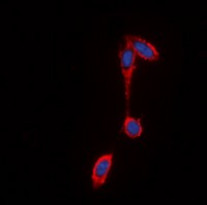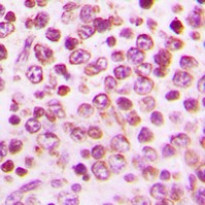ARG66475
anti-FFAR2 / GPR43 antibody
anti-FFAR2 / GPR43 antibody for ICC/IF,IHC-Formalin-fixed paraffin-embedded sections,Western blot and Human
Overview
| Product Description | Rabbit Polyclonal antibody recognizes FFAR2 / GPR43 |
|---|---|
| Tested Reactivity | Hu |
| Tested Application | ICC/IF, IHC-P, WB |
| Host | Rabbit |
| Clonality | Polyclonal |
| Isotype | IgG |
| Target Name | FFAR2 / GPR43 |
| Antigen Species | Human |
| Immunogen | KLH-conjugated synthetic peptide within the C-terminal region of Human FFAR2 / GPR43. |
| Conjugation | Un-conjugated |
| Alternate Names | FFA2R; Free fatty acid receptor 2; G-protein coupled receptor 43; GPR43 |
Application Instructions
| Application Suggestion |
|
||||||||
|---|---|---|---|---|---|---|---|---|---|
| Application Note | IHC-P: Antigen Retrieval: Heat mediation was performed in Sodium citrate buffer (pH 6.0). * The dilutions indicate recommended starting dilutions and the optimal dilutions or concentrations should be determined by the scientist. |
||||||||
| Observed Size | ~ 42 kDa |
Properties
| Form | Liquid |
|---|---|
| Purification | Affinity purification with immunogen. |
| Buffer | 0.42% Potassium phosphate (pH 7.3), 0.87% NaCl, 0.01% Sodium azide and 30% Glycerol. |
| Preservative | 0.01% Sodium azide |
| Stabilizer | 30% Glycerol |
| Storage Instruction | For continuous use, store undiluted antibody at 2-8°C for up to a week. For long-term storage, aliquot and store at -20°C. Storage in frost free freezers is not recommended. Avoid repeated freeze/thaw cycles. Suggest spin the vial prior to opening. The antibody solution should be gently mixed before use. |
| Note | For laboratory research only, not for drug, diagnostic or other use. |
Bioinformation
| Database Links | |
|---|---|
| Gene Symbol | FFAR2 |
| Gene Full Name | free fatty acid receptor 2 |
| Background | This gene encodes a member of the GP40 family of G protein-coupled receptors that are clustered together on chromosome 19. The encoded protein is a receptor for short chain free fatty acids and may be involved in the inflammatory response and in regulating lipid plasma levels. [provided by RefSeq, Apr 2009] |
| Function | G protein-coupled receptor that is activated by a major product of dietary fiber digestion, the short chain fatty acids (SCFAs), and that plays a role in the regulation of whole-body energy homeostasis and in intestinal immunity. In omnivorous mammals, the short chain fatty acids acetate, propionate and butyrate are produced primarily by the gut microbiome that metabolizes dietary fibers. SCFAs serve as a source of energy but also act as signaling molecules. That G protein-coupled receptor is probably coupled to the pertussis toxin-sensitive, G(i/o)-alpha family of G proteins but also to the Gq family. Its activation results in the formation of inositol 1,4,5-trisphosphate, the mobilization of intracellular calcium, the phosphorylation of the MAPK3/ERK1 and MAPK1/ERK2 kinases and the inhibition of intracellular cAMP accumulation. May play a role in glucose homeostasis by regulating the secretion of GLP-1, in response to short-chain fatty acids accumulating in the intestine. May also regulate the production of LEP/Leptin, a hormone acting on the central nervous system to inhibit food intake. Finally, may also regulate whole-body energy homeostasis through adipogenesis regulating both differentiation and lipid storage of adipocytes. In parallel to its role in energy homeostasis, may also mediate the activation of the inflammatory and immune responses by SCFA in the intestine, regulating the rapid production of chemokines and cytokines. May also play a role in the resolution of the inflammatory response and control chemotaxis in neutrophils. In addition to SCFAs, may also be activated by the extracellular lectin FCN1 in a process leading to activation of monocytes and inducing the secretion of interleukin-8/IL-8 in response to the presence of microbes. Among SCFAs, the fatty acids containing less than 6 carbons, the most potent activators are probably acetate, propionate and butyrate. Exhibits a SCFA-independent constitutive G protein-coupled receptor activity. [UniProt] |
| Cellular Localization | Cell membrane; Multi-pass membrane protein. [UniProt] |
| Calculated MW | 37 kDa |
Images (3) Click the Picture to Zoom In
-
ARG66475 anti-FFAR2 / GPR43 antibody ICC/IF image
Immunofluorescence: Formalin-fixed THP-1 cells were permeabilized with 0.1% Triton X-100 in TBS for 5-10 minutes and blocked with 3% BSA-PBS for 30 minutes at RT. Cells were stained with ARG66475 anti-FFAR2 / GPR43 antibody (red) in 3% BSA-PBS and incubated overnight at 4°C in a hidified chamber. DAPI (blue) for nuclear staining.
-
ARG66475 anti-FFAR2 / GPR43 antibody IHC-P image
Immunohistochemistry: Formalin-fixed and paraffin-embedded Human tonsil. Antigen Retrieval: Heat mediation was performed in Sodium citrate buffer (pH 6.0). The section was then stained with ARG66475 anti-FFAR2 / GPR43 antibody at RT and detected using an HRP conjugated compact polymer system. DAB was used as the chromogen. The section was then counterstained with haematoxylin and mounted with DPX.
-
ARG66475 anti-FFAR2 / GPR43 antibody WB image
Western blot: THP-1 whole cell lysate stained with ARG66475 anti-FFAR2 / GPR43 antibody.








